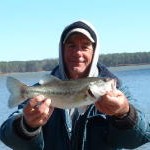FISHING AFTER COLD FRONTS
by Scott Suggs
First, let me say that as an angler I understand that bass fishing after a cold front can be very frustrating. Especially if you fish in areas with Florida-strain largemouth bass, cold fronts can pretty much be the excuse you need to park the boat and head to a deer stand or sit in the house and watch football.
But cold fronts are just a fact of life for most of the country from about October through April. That’s a long period of time to simply give up on bass fishing. Those fish have to eat at some point during this six-month stretch; fish are going to be caught by someone somewhere. I figure that might as well be me. So learning to deal with the effects of cold fronts as it relates to bass fishing is the first step towards keeping my days on the water successful when everyone else has packed it in for the year, leaving you on the water with cold air temperatures and bluebird skies.
As the air temperature cools from a cold front, the surface temperature of the water will also begin to cool. This will force bass in shallow water to seek holding areas in deeper water where the temperature will be warmer. I use my electronics to find brush piles in deep water or deep-water ledges near channel swings or secondary points. Once I find them I do like to use a jig or a drop shot, something with a vertical presentation. A ¾-ounce football jig tipped with a Berkley PowerBait Chigger Craw and dragged slowly through these areas can be very effective. Drop shotting a Berkley Gulp! Sinking Minnow can be effective, too. Just shake the rod tip, trying not to move the bait too far.
Sometimes smaller baits can be they key, too. If you normally catch fish on a 10-inch Berkley PowerBait Power Worm, try a 6-inch worm; same goes for stick- and creature-style baits. Being cold blooded the body temperature of a bass is regulated by its environment. When the water cools, they become lethargic and their metabolism slows. Big meals aren’t needed, but a easy meal – one that won’t require much work to capture or consume – is always welcome.
Don’t overlook tight cover, either. Bushes, root balls, dock pilings, logs and rock can sometimes draw in large numbers of bass. They will huddle in these protected areas where the water temps are move stable. Trying pitching jigs or wacky rigged soft plastics like a PowerBait Fat Dover Crawler in these areas and let them sink. It might take some time, but you can catch these fish.
More than anything, fishing after a cold front requires anglers to slow down. The bass are going to be moving and reacting slowly, so your presentation should not be fast. Bait like Gulp! are ideal for slow presentations because the scent and flavor that are built into the baits works even better when fished slowly. The scent clouds will fill the area and actually draw in fish – even lethargic ones – in search of an easy meal.
Fishing after cold fronts isn’t ideal, but don’t let low air temperatures keep you off the water. This time of the year can yield some very big fish that have been gorging on the shad that spawn in the backs of coves. Plus, there won’t be much boat traffic. Just change your tactics a little and go catch some big bass while everyone else is sitting around the house.
